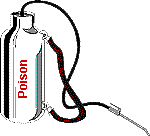Backyard Neurotoxin On the Way Out EPA Cites Unacceptable Risk of Diazinon to Consumers |
Backyard Neurotoxin On the Way Out EPA Cites Unacceptable Risk of Diazinon to Consumers |
|
December 11, 2000
The EPA Does It AgainLast summer, the US Environmental Protection Agency (EPA) announced that the pesticide called chlorpyrifos would be banned. On December 5, 2000, the EPA announced that another widely used pesticide called diazinon will also be phased out.
Diazinon: A Popular Backyard Pesticide Diazinon is used on lawns, around homes and in gardens to kill
insects such as chinchbugs, earwigs, aphids, fruitflies, mites, cutworms,
crane flies, ants, silverfish, and cockroaches. According to the
EPA, over 13 million pounds of diazinon are used each year. About 80% of
the pesticide is used on lawns and for residential control of insects.
Both chlorpyrifos and diazinon are organophosphate chemicals, known neurotoxins that
target and poison the nervous system. Specifically, organophosphates
target the acetylcholine neurotransmitter
system.
Diazinon is used on lawns, around homes and in gardens to kill
insects such as chinchbugs, earwigs, aphids, fruitflies, mites, cutworms,
crane flies, ants, silverfish, and cockroaches. According to the
EPA, over 13 million pounds of diazinon are used each year. About 80% of
the pesticide is used on lawns and for residential control of insects.
Both chlorpyrifos and diazinon are organophosphate chemicals, known neurotoxins that
target and poison the nervous system. Specifically, organophosphates
target the acetylcholine neurotransmitter
system. One of the major sites of the acetylcholine action
is at the neuromuscular junction. The neuromuscular junction is where
acetylcholine is released from a neuron and received by muscle cells. An
enzyme called acetylcholinesterase (AChE) breaks down acetylcholine into
acetate and choline. The action of acetylcholine is therefore stopped by
AChE. Organophosphates act by inhibiting AChE. Therefore, in the
presence of organophosphate pesticides, acetylcholine levels
increase because it is not being broken down. This
results in overactivation of the acetylcholine system which may cause
symptoms such as nausea, vomiting, muscle weakness, dizziness, and
respiratory paralysis in humans. High doses of this poison can even cause
death. Many nerve agents (chemical weapons) also
cause illness and death by inhibiting acetylcholinesterase. One of the major sites of the acetylcholine action
is at the neuromuscular junction. The neuromuscular junction is where
acetylcholine is released from a neuron and received by muscle cells. An
enzyme called acetylcholinesterase (AChE) breaks down acetylcholine into
acetate and choline. The action of acetylcholine is therefore stopped by
AChE. Organophosphates act by inhibiting AChE. Therefore, in the
presence of organophosphate pesticides, acetylcholine levels
increase because it is not being broken down. This
results in overactivation of the acetylcholine system which may cause
symptoms such as nausea, vomiting, muscle weakness, dizziness, and
respiratory paralysis in humans. High doses of this poison can even cause
death. Many nerve agents (chemical weapons) also
cause illness and death by inhibiting acetylcholinesterase.
Diazinon in the Garage or Tool Shed? So, what do you do if you have a bottle or can of diazinon at
your house? It is still legal to buy and use diazinon products; just make
sure you follow the directions on the label. The EPA recommends other
precautions when using diazinon: So, what do you do if you have a bottle or can of diazinon at
your house? It is still legal to buy and use diazinon products; just make
sure you follow the directions on the label. The EPA recommends other
precautions when using diazinon:
|
References and further information:
|
| GO TO: | Neuroscience In The News | Explore the Nervous System | Table of Contents |
![[email]](./gif/menue.gif) Send E-mail |
 Fill out survey |
 Get Newsletter |
 Search Pages |
 Take Notes |